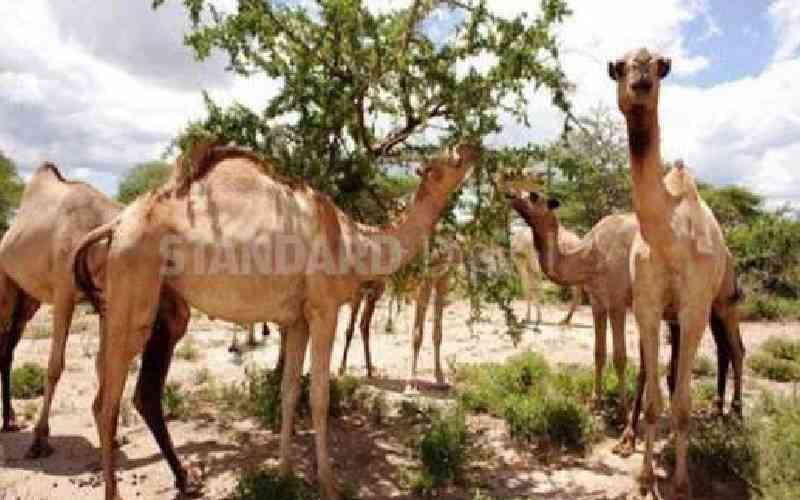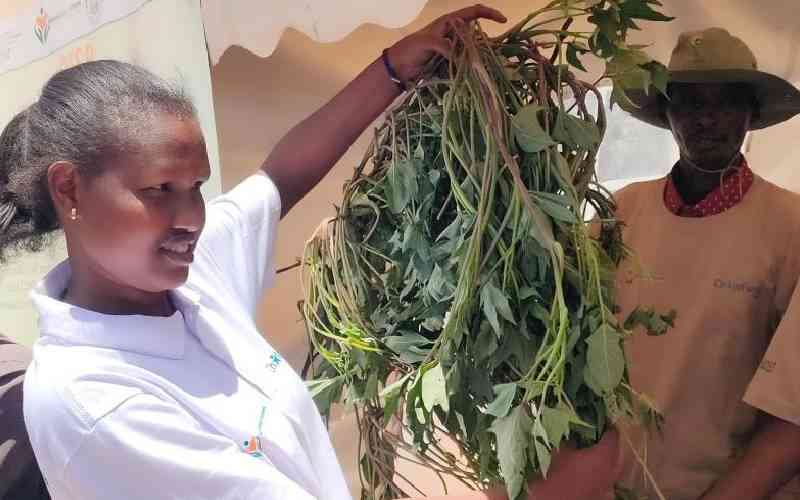 |
|
Samburu |
Samburu; Kenya: The double cabin all-wheel drive vehicle roars past ditches and dikes. The women and children of Maralal in Samburu are rushing home with stacks of food, fuel wood and different forms of domestic merchandise.
Dusk is fast approaching and the sun is sinking in the horizon and we have to rush to the hotel in Maralal town.
It is this same place where, in 2012, 42 police officers lost their lives ruthless control bandits.
With such gory tales, there is an eerie feeling in the air, what with the uneasy quietness.
Beautifully coloured birds chirp and flutter in the evening air, as if happy at the falling darkness.
Dust from the dry earth rises beneath the wheels and as it mixes up with air, its smell reminds us that we are indeed far from the assumed safety of city life.
It is on our way from Maralal to Barsaloi the next morning that Samburu unmasks its beauty.
TRADITIONAL DRESSES
The journey past valleys, rocks, hills and thickets is tiresome. The sun shining on the African savannah has never been this fierce.
“We will arrive in 3 to 4 hours,” Moses Otieno, a manager in charge of maternal health project run by Amref and M-Pesa Foundation tells the team comprising journalists and other field coordinators.
The journey seems tougher than we were made to believe. Lots of trees and shrubs obscure what lies ahead.
On our way we meet some Samburu women, clad in traditional dresses. The colour of beauty here is scarlet. Layers of necklaces and traditional bead work are the symbols of womanhood.
Occasionally, we bumped into herds of cattle, sheep and goats. The young women, tasked with watching over the animals, dart between thick vines and shrubby entanglements to keep track of the animals.
The morans, youthful warriors, look fearless in their traditional regalia. Majority have ochre on their clean shaven heads. Beaded collars decorated with jingly metals glitter in the sun.
Each one has a machete, safely tucked in a leather sheath just in case he needs to protect the village from intruders or fight off a wild animal.
Stay informed. Subscribe to our newsletter
MARGINALISED LANDS
The steep slope down the sides of Opiroi hill is scary.
However, for all-wheel drive vehicle designed to handle harsh terrain, going down an obtusely curved surface is not anything to fret over.
“Piece of cake,” our driver says with a deceiving smile. The escarpment in between the hills is magnificent. The green canopy formed by the shrubs is a beautiful sign that after all, the rain gods reside among the Samburu. A shallow stream with a silted beds has just enough water to give it meaning.
Further down, the Opiroi Catholic Church looks medieval.
Built and structured to match traditional architecture, it offers spiritual guidance to many in the area.
It is perhaps a reminder that modernism is yet to get a foothold in the marginalised lands of the Samburu.
We arrive in Barsaloi at 11am. A signage erected by the Catholic Mission advocating for peace welcomes us.
We spend the day mingling with local residents. Here, electric power is a foreign phrase. The wind blows and cools the weary. In the afternoon though, the true bareness of the land become clear. The only friendly place outdoors is under a tree.
As evening begins to fall, I feel a strange composure to be away from telephone network, electricity, piped water, processed food and the safety of hospitals.
The ilakir (eyes) of Enkai (God) have emerged in their trillions, making for a spectacular astronomical view.
VANTAGE VIEW
The Catholic mission, the only place in Barsaloi that can provide accommodation, is our home through the night. The balcony of the guest house provides a vantage view to swathes of unoccupied land. The air is clean, untainted. The goat meat that was our supper is unblemished.
Spending the night in the nothingness of Samburu gives an incomprehensible feeling.
Bandits roam the wild in Barsaloi — and the greater Samburu — and dictate lifestyles. And so when morning came, all of us breathed a collective sigh of relief.
There is something about spending time in natural spaces — places where nature has not been trampled upon, places away from the riches of life and where man is at the mercy of nature.
Samburu is such a place.
 The Standard Group Plc is a
multi-media organization with investments in media platforms spanning newspaper
print operations, television, radio broadcasting, digital and online services. The
Standard Group is recognized as a leading multi-media house in Kenya with a key
influence in matters of national and international interest.
The Standard Group Plc is a
multi-media organization with investments in media platforms spanning newspaper
print operations, television, radio broadcasting, digital and online services. The
Standard Group is recognized as a leading multi-media house in Kenya with a key
influence in matters of national and international interest.
 The Standard Group Plc is a
multi-media organization with investments in media platforms spanning newspaper
print operations, television, radio broadcasting, digital and online services. The
Standard Group is recognized as a leading multi-media house in Kenya with a key
influence in matters of national and international interest.
The Standard Group Plc is a
multi-media organization with investments in media platforms spanning newspaper
print operations, television, radio broadcasting, digital and online services. The
Standard Group is recognized as a leading multi-media house in Kenya with a key
influence in matters of national and international interest.










